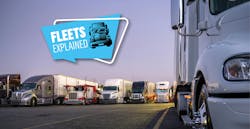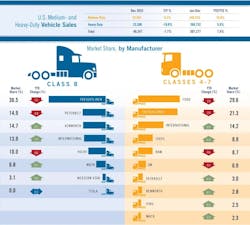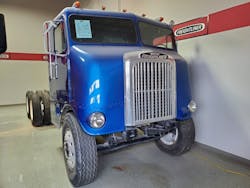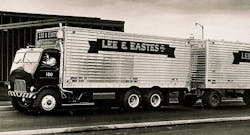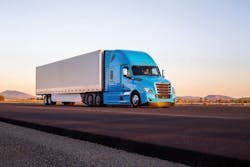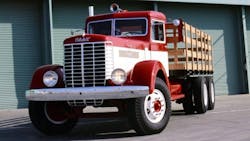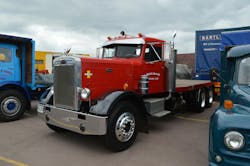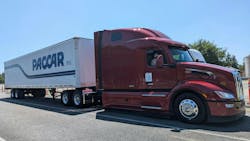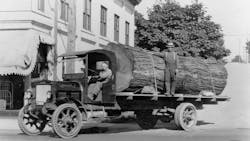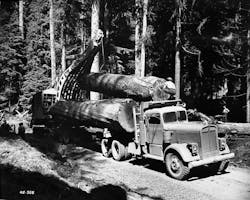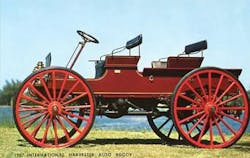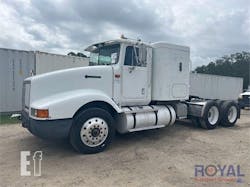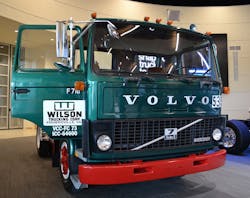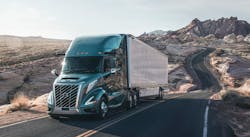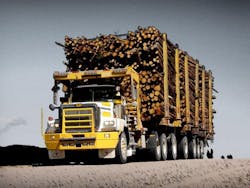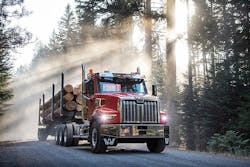Fleets Explained: History of the 7 major heavy-duty truck manufacturers in the U.S.
This is part of FleetOwner's Fleets Explained, a Trucking 101 series to break down aspects of the trucking and fleet management industries. You can read more from the series, launched in May 2024, at fleetowner.com/fleets-explained. To submit topic ideas, clarifications, and corrections, email [email protected].
Seven brands from four global companies account for 99.9% of all new Class 8 truck sales in the U.S. While some nascent manufacturers are entering the alternative fuel heavy-duty trucking space, the traditional trucking OEMs continue to dominate the over-the-road fleet market.
After the military was the first to extensively deploy trucks in its operations during World War I, the trucking industry grew as a new, more versatile supply chain solution in the late 1920s and 1930s. The industry experienced a boom in the 1950s and 1960s as the U.S. Interstate Highway System was developed, creating more ways to move freight along roads other than rail.
Since then, dozens of vehicle manufacturers have built heavy-duty trucks for fleets. Several of these OEM companies developed from businesses that initially produced equipment for farms, trolleys, or automobiles.
Ford Motor Company, for example, produced Class 8 semi-trucks until the late 1990s, when it sold its heavy-duty truck line to Freightliner. Today, Ford owns the largest medium-duty (Class 4 to 7) market share in the U.S.
Other legacy heavy-duty truck makers that date back to the early 20th century were acquired by rivals—such as Brockway Motor Company, which Mack Trucks bought in 1956 and shut down in 1977. As the U.S. over-the-road freight industry grew, international companies looked to enter the thriving North American truck market—such as Volvo Group’s acquisition of most of White Motor Company in 1981.
Today, seven major North American truck OEMs remain subsidiaries of four global manufacturing corporations. But a number of new companies focused on battery electric, hydrogen, or other alternative powertrains are attempting to enter the market. These include companies such as Tesla, which has some of its electric Class 8 vehicles in early fleet operations, and Nikola, which began selling its hydrogen fuel cell EV Class 8 truck in 2023. Several other start-up manufacturers are looking to enter the alternative fuel transportation race.
See also: Tesla Semi: Will it ever live up to the hype?
However, the seven largest Class 8 truck makers made up 99.9% of all new over-the-road, heavy-duty truck sales in 2023, according to the American Truck Dealers trade association. Listed below is an overview of those seven heavy-duty truck OEMs and their histories in North American fleet operations.
Freightliner truck history
The most popular semi-truck brand in the U.S. is Freightliner, a Daimler Truck subsidiary. Beginning as part of Consolidated Freightways in 1929, the OEM launched in the early 1940s. Freightliner owned a 36.5% market share of Class 8 truck sales in 2023, according to ATD. It was acquired by Germany-based Daimler AG in 1981 and is now part of Daimler Truck North America, which is based in Portland, Oregon.
A pioneer in truck lightweighting, Leland James spun off Freightliner from Consolidated Freightways in 1942 to build trucks with aluminum instead of steel. Freightliner sold its first cabover sleeper tractor in the 1950s.
Its distribution across North America grew after Freightliner teamed up with White Motor Company, the largest heavy-duty OEM at the time. Until the 1970s, White sold and distributed trucks branded as White Freightliner. But after White faced financial troubles in the 1970s, Freightliner became its own manufacturer and distributor in 1974 while retaining most of the White dealer network, which helped it maintain a foothold on the North American market.
Today, the Freightliner Cascadia is the most popular Class 8 truck model in the U.S. Since its debut in 2007, the Cascadia has undergone significant redesigns over the years—most recently in its third-generation model in 2018. A battery-electric version, the eCascadia, began serial production in 2022. The OEM plans to offer Daimler Truck’s Torc Robotics autonomous driving technology for Cascadias in 2027.
See also: Freightliner produces milestone 1 millionth Cascadia
Peterbilt truck history
Peterbilt Trucks was established in 1939. It has been part of the Paccar company since 1958. Currently the second-most popular brand in the U.S., Peterbilt had a 14.9% Class 8 market share in 2023, according to ATD.
T.A. Peterman, a logging businessman who had found success modifying Army trucks to haul commodities, purchased Fageol Truck & Coach Company from Sterling Motor Truck in 1938. He sold his first 14 Peterbilt trucks in 1939. That number grew to more than 80 in 1940, helping Peterbilt land a military contract to supply the U.S. with heavy-duty vehicles during World War II.
After Peterman died in 1945, his wife sold the company to several Peterbilt managers. A little over a decade later, Pacific Car & Foundry, owner of Kenworth Trucks, bought the truck maker. Pacific Car & Foundry would eventually rebrand as Paccar in 1971 but kept the Peterbilt brand operating on its own despite being Kenworth’s biggest rival.
Today, Peterbilt produces several long-haul, regional, and vocational Class 8 trucks, including its on-highway flagship Model 579, most recently updated in 2021. Peterbilt rolled out a battery-electric Model 579EV in 2020. The OEM has plans to begin producing a hydrogen fuel cell Class 8, the Peterbilt Model 579FCEV, in 2025. The OEM also recently updated its popular long-nose truck series—which dates back to 1954—with the new Model 589 in 2023, replacing the Model 389.
Kenworth truck history
Kenworth, Paccar’s older truck brand, was founded in 1923 by Harry W. Kent and Edgar K. Worthington in Seattle to supply Pacific Northwest loggers with equipment capable of hauling heavy loads through rugged terrain. One hundred years later, Kenworth ranked third in Class 8 market share in 2023, according to ATD.
After initially producing gasoline-powered, six-cylinder trucks, Kenworth was the first to make diesel engines standard equipment in 1933. A few years later, the OEM introduced the first truck sleeper cab.
During World War II, the truck maker became a military supplier, building wreckers and aircraft parts. To keep up with demand, the OEM developed a moving assembly line and gained more knowledge on using aluminum in equipment. This led it to build its first aluminum frame rail.
After the war, Pacific Car & Foundry made a deal to acquire the OEM, which operated as a subsidiary of the company that would eventually be renamed Paccar. With a new parent company, Kenworth’s distribution ballooned between 1946 and 1950 to 27 locations outside the U.S., as foreign sales accounted for 40% of its business.
Today, the Kenworth T680 Next Generation serves as its flagship heavy-duty truck. It debuted in 2021 as the latest update of the Kenworth T600 line, which entered production in the 1980s and was a pioneer in modern semi-truck design focused on aerodynamics and fuel economy. The first T680 hit the market in 2013.
Kenworth now offers a battery-electric version of its flagship called the T680E, designed for regional operations as well. In addition, the OEM has partnered with Toyota to create a Class 8 hydrogen fuel cell electric truck expected to begin production in 2025.
International truck history
With a history dating back to 1902, International Motors is a subsidiary of Germany-based Traton AG (Volkswagen Group), which acquired the former Navistar International Corporation in 2021. International Class 8 trucks made up 13.9% of 2023 sales, according to ATD. The company is headquartered in Lisle, Illinois.
Chicago-based International Harvester sold its first engine-powered farm tractor in 1906 and an early farm pickup-style truck called the Auto Buggy in 1908. The company continued to build more trucks for use off the farm, including its A series, designed to haul heavier loads over greater distances, in 1930. The company grew as a vehicle manufacturer through the 20th century, with a range of vehicles for trucking, agriculture, construction, consumer trucks, and sport utility vehicles.
By 1985, the company divested almost all its properties except for its truck and engine divisions. The OEM became Navistar International Corporation in 1986. Between 2016 and 2018, it revamped most of its truck offerings, including new severe-duty offerings (HX Series and HV Series) and the LT Series, International’s current flagship Class 8 tractor, which debuted in 2017.
Since its acquisition by Traton Group earlier this decade, the U.S. truckmaker launched its International S13 Integrated Powertrain, the final internal combustion engine it plans to design.
In 2024, the OEM rebranded itself as International Motors, abandoning its corporate Navistar name. International leaders said the rebranding was part of a company strategy to expand beyond truck and powertrain engineering and production, expanding business strategies to focus on transportation solutions and streamlining fleet customer and driver experiences.
Volvo trucks history
Europe’s Volvo Group entered the North American truck market when it acquired White Motor Company assets in 1981. Now branded as Volvo Trucks North America, Volvo owned a 10% market share in 2023, according to ATD. With its global headquarters in Gothenburg, Sweden, VTNA’s operations are based in Greensboro, North Carolina.
A year after producing its first passenger car, Volvo introduced its first truck, the LV4, in 1928 and found success within the European market. The company sold its first 500 trucks in six months. Volvo’s presence in Europe grew during World War II and into the 1950s. The company invented the three-point seat belt in the 1950s and built a global reputation for vehicle safety. Many of its early and later truck models are on display at the World of Volvo, a cultural center that opened in Gothenburg in 2024.
The Autocar and Sterling truck brands came with the White acquisition in 1981, when the company upgraded some of its U.S. trucks. While it continued to sell and brand some vehicles as White Trucks through the 1980s and 1990s, the Swedish company launched its own U.S. brand in 1986. It also formed a joint venture with General Motors to produce heavy-duty trucks under WhiteGMC. It was discontinued in the mid-1990s before Volvo bought out GM’s stake in the venture and rebranded itself as Volvo Trucks North America. Volvo Group sold its Volvo Cars division in 1999, and while the trucks and automobiles share the same branding (and a lot of history), they have been separate entities for 25 years.
Volvo’s VN series, a precursor to its flagship VNL model, debuted in 1996. The long-haul VNL and regional-haul-focused VNR debuted in 2017. The truckmaker was the first legacy North American OEM to begin serial production of a Class 8 EV, the VNR Electric, in 2021. The OEM launched its all-new VNL in 2024, saying the new Class 8 truck was designed to support modern and future alternative fuel powertrains, including renewable internal combustion engines, BEVs, and fuel cells. A year later, Volvo Trucks followed up with a refreshed VNR truck for regional, bulk, and flatbed operations.
See also: New Volvo VNL sets sights on trucking's next decade
Mack truck history
After building its first motor-powered vehicle in 1900, the Mack Brothers Company built its first truck in 1905. Mack developed its reputation for durability during World War I when the British military used the Mack AC model as a front-line supply vehicle. Soldiers gave the trucks the “Bulldog” nickname. The company adopted its current Mack Trucks name in 1922 and added the bulldog hood ornament to all models in 1932.
Mack has been part of Volvo Trucks North America since its former parent company, Renault Vehicules, was acquired by Volvo Group in 2001. According to ATD, Mack had a 6.8% market share in 2023. After being founded in Brooklyn, New York, and spending more than a century based in Allentown, Pennsylvania, Mack is now headquartered in Greensboro, North Carolina.
Primarily a vocational on-road truck producer, Mack became a national symbol of hard work in the 1930s, when the trucks were used in countless Work Projects Administration construction projects, including the Hoover Dam. The OEM acquired rival truck maker Brockway Motor Company in the 1950s and continued to sell the truck brand for 20 years before discontinuing it. In the late 1970s, Renault began acquiring more shares of Mack, eventually making the company a subsidiary of France-based Renault Vehicules Industriels in 1990. Eleven years later, Volvo Group made Mack and Renault part of Volvo Trucks.
The Mack Pioneer, a Class 8 highway truck launched in 2025, is part of the OEM's strategy to gain market share in the long-haul tractor market. It joins the Mack Anthen, which debuted in 2017 but found more success with its day cab for regional haul operations. The heavy-duty Mack Granite is a Class 8 vehicle popular for dump truck configurations and built for severe services, such as construction and other vocational operations. Its LR model is designed for refuse services and was the OEM’s first Class 8 EV offering.
Western Star truck history
Now part of Daimler Truck North America, Western Star began as a Canadian manufacturing division of White Motor Company in 1967. However, the White assets Volvo Group acquired in 1981 did not include Western Star. The brand was part of other corporations for the next two decades until DaimlerChrysler acquired it in 2000. With a 3.1% market share in the U.S., Western Star is now an OEM subsidiary of Daimler Truck North America.
With its Canadian roots, White Western Star—as it was initially branded—trucks were designed for rugged logging, mining, and oil field operations. In 2020, Western Star began revamping its on-highway trucks with the first of three X-Series models, the 49X. It later added the 47X in 2021 and the 57X in 2022, replacing the previous 4700, 4900, and 5700XE models.
About the Author
Josh Fisher
Editor-in-Chief
Editor-in-Chief Josh Fisher has been with FleetOwner since 2017. He covers everything from modern fleet management to operational efficiency, artificial intelligence, autonomous trucking, alternative fuels and powertrains, regulations, and emerging transportation technology. Based in Maryland, he writes the Lane Shift Ahead column about the changing North American transportation landscape.
